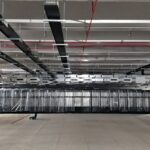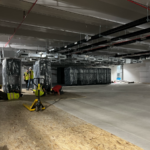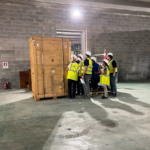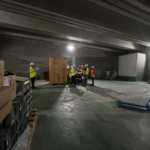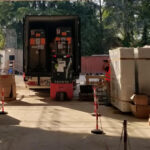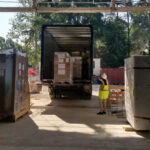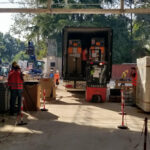Leonardo
The objective is to complete the installation by autumn
Bologna 21 July 2022
30 trucks, 157 racks, 4,993 servers, for a total weight of 360,000 kilos, and hundreds of kilometers of cables. It will take the whole summer to complete the delivery of the European supercomputer Leonardo, whose first components arrived this morning at the Bologna Technopole.
THE PROGRAM
Today the first two trucks – about 4 truck will arrive every week – have delivered 16 racks, or “cabinets”, and the related servers, or “muscles” that will allow the supercomputer managed by Cineca to perform 250 million billion operations per second. The overall 157 racks will be neatly arranged in 9 rows in the Technopole data center but, to install them, the technicians will not wait for the completion of the delivery at the end of the summer. The racks unloaded today have already been brought into the heart of the new data center, and within a few hours they were already positioned at the back of the room, ready for the assembly of the hardware components. The installation operations will also start next week, which will therefore proceed incrementally, delivery after delivery
The power-on of the supercomputer will also be incremental: it will proceed in groups of two rows at a time, as the connection to the electrical network and to the pipes in which water will flow for cooling, placed under the floor, intead of waiting for the complete installation of all the racks.
The distribution of the racks in the rows in the room has been designed in order to optimize both the design of the network that connects all the servers, and the efficiency and resilience of the power supply and cooling systems.
In addition to the complexity that accompanies the installation of a supercomputer, it must be remembered that Leonardo – as happens with the very few systems with such high performance – is essentially one of a kind: it is like a very powerful prototype, efficient and fully functional, which will not see a large-scale production. A project possible thanks to the long experience of CINECA, which in 53 years of activity, has acquired the preparation required to install and effectively operate a system of such performance.
THE PRESIDENT'S COMMENT
Today a new, decisive phase begins in the path that will see Leonardo’s arrival at the Technopole. Declares the president of CINECA Francesco Ubertini. After having built the “home” of the supercomputer, we now enter the last mile of the journey, which will gradually bring our jewel to life. This is a unique infrastructure in the world and strategic for the future: an extra gear for our country and for Europe.
the SUPERCOMPUTER
The Leonardo system, based on Atos Sequana XH2000 technology, will have a computational power of almost 250 PFlops and will be equipped with over 100 PB of data storage capacity. The system will be interconnected via a 200 Gb /s InfiniBand data network, which will allow an exchange of information between the processing units, which is crucial to tackle frontier scientific challenges.
In fact, Leonardo will provide 10 times the computing power of the current flagship Cineca Marconi100 system. In practice, this translates into a greater definition of the scientific models used, for example global climate simulations with a resolution of one kilometer, or a greater speed of simulation, a key feature in the context of natural disasters in which it is critical to be able to have answers in a very short time.
A brief interview with Daniela Galetti, head of HPC systems management group at CINECA.
THE EUROPEAN CONTEXT
Leonardo supercomputer is co-financed with 240 million euros by the EuroHPC Joint Undertaking, and the Ministry of University and Research. It will be managed by CINECA at the Bologna Technopole, and will be one of the resources of the National Research Center in High Performance Computing, Big Data and Quantum Computing funded by the PNRR and recently established.
The applications
In addition to traditional scientific disciplines, such as physics, astrophysics, chemistry, fluid dynamics, Leonardo will have the task of tackling “frontier” projects, such as personalized medicine, climate change, the search for new energy sources, the development of new materials, bioengineering. A part of its resources will be devoted to the development of industrial projects, and projects in which scientific research and industrial research collaborate, such as projects based on artificial intelligence, or the development of digital twins (digital twins, which concern the simulation of industrial plants for predictive purposes, or for process optimization). Furthermore, it will be the protagonist of the search for solutions to the challenges of the present and the future: pandemics, climatic emergencies, up to the creation of the “digital twin” of the Earth.
The different stages of the supecomputer installation will be documented on our site.

